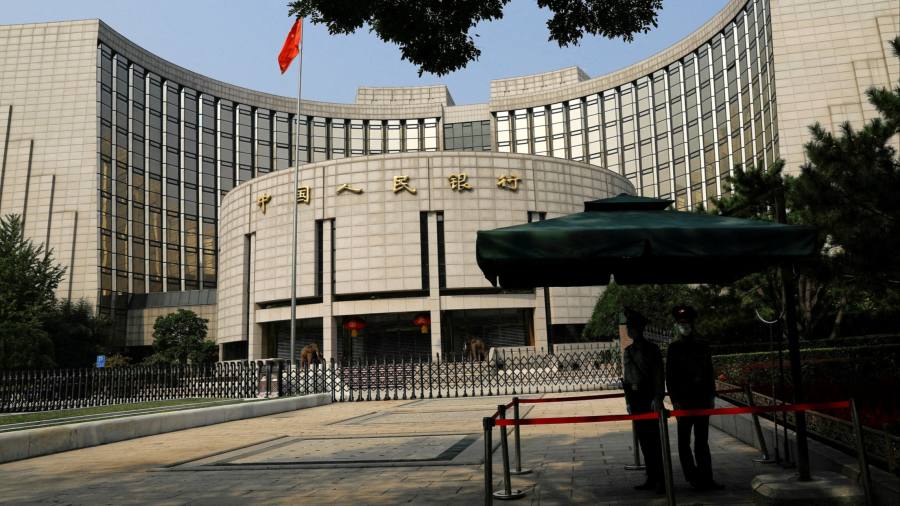The renminbi’s share of trade finance has more than doubled since the invasion of Ukraine, analysis by the Financial Times has found — a surge that analysts say reflects both greater use of China’s currency to facilitate trade with Russia and the rising cost of dollar financing.
Trade financing data from Swift, the international payments and financing platform, shows that the renminbi’s share by value of the market had risen from less than 2 per cent in February 2022 to 4.5 per cent a year later. Those gains put China’s currency in close contention with the euro, which accounts for 6 per cent of the total.
Both are, however, still a tiny fraction of the dollar’s share. This stood at 84.3 per cent in February 2023, down from 86.8 per cent a year earlier.
“This is a substantial move,” said Mansoor Mohi-uddin, chief economist at Bank of Singapore. “It’s hard to think of anything else that could be behind this step change other than what’s happened with the war in Ukraine.”
The Chinese currency’s growing share of trade finance — in which lenders extend credit to facilitate the cross-border movement of goods — represents a boon for Beijing in its drive to accelerate renminbi internationalisation and a stark challenge to the west, which has sought to use sanctions to bar major Russian financial institutions from utilising Swift.
“It’s likely that a lot of this, given the timing, represents Russian trade [with China] which is done through intermediaries,” said Arthur Kroeber, founding partner of China-focused research group Gavekal Dragonomics. “The fact that Russia itself is cut off from Swift is perhaps irrelevant.”
“There’s clearly a lot of Russian oil that’s showing up in China via the Middle East and Malaysia,” he added, pointing to an “explosion” in Chinese oil import volumes from Malaysia since March of last year that exceeds the country’s production capacity.
The People’s Bank of China had carried out a concerted internationalisation drive in the years leading up to August 2015, when a devaluation led to severe capital flight. This forced the central bank to reverse course and impose draconian capital controls that stalled China’s progress in promoting the currency’s global use.
The renminbi’s latest rise through the ranks of trade finance currencies has not been matched by greater use in international payments made on Swift, which have plateaued at about 2 per cent of the global total.
However, Russia does have access to the Cross-Border Interbank Payment System (Cips), China’s alternative to Swift, and last year bilateral trade between the two countries rose to a record $185bn as Russian companies paid for most purchases of Chinese goods in renminbi. Total settlements on Cips came to Rmb97tn ($14tn) in 2022, central bank data showed, a year-on-year increase of 21 per cent.
“There’s a limit to how much you can unearth in terms of the precise mechanics of how these payments occur,” Kroeber said. “But I would suspect a very substantial portion of this increase in trade finance, when you get to the bottom of it, reflects transactions involving Russia.”
Analysts and economists said the rising cost of dollar funding had also made China’s currency relatively more attractive for trade financing. The US Federal Reserve has raised rates nine times since 2022, while the PBoC has cut its benchmark loan prime rate twice over the same period.
Guan Tao, global chief economist at Bank of China International and a former official at the State Administration of Foreign Exchange, said the currency’s rise in trade finance “relates to the divergence of US and China monetary policies . . . the renminbi’s role has changed from a high interest rate currency into a low interest rate currency”.
“On the interest rate side . . . with the US having hiked, on a relative basis the renminbi is cheaper. We do see recently there is more interest in trade finance being done in renminbi,” said Kelvin Lau, senior economist for greater China at Standard Chartered. “With or without Russia, structurally we’re seeing renminbi internationalisation making a comeback.”
The PBoC has shifted its renminbi internationalisation strategy since the beginning of 2022, according to a recent paper from Zhang Ming, deputy director of the Department of International Finance at the Chinese Academy of Social Sciences.
Rather than focus on pushing more renminbi pricing for crude oil and expanding foreign investor access to onshore securities as it did up until the end of 2021, Zhang said, the central bank has begun aggressively pushing for greater use of the currency in settlement of cross-border commodities trades and improving global access to derivatives tied to renminbi assets.
That sharper focus on commodities settlement is evident from deals such as the one struck last month with Brazil, which will allow the largest economies in Asia and South America to conduct trade and financial transactions in their own currencies.
“China has a strong incentive to push forward renminbi internationalisation to manage the rising risks of geopolitical tensions and US-China decoupling,” said Zhi Xiaojia, head of Asia research at Crédit Agricole. “It has intensified international dialogue and made some positive progress on this front, especially with the Association of Southeast Asian Nations, Middle Eastern and Latin [American] economies.”
However, in light of the tight capital controls maintained by China’s central bank, few experts expect the renminbi to quickly rocket up the ranks of global payments currencies.
“The Chinese are using a salami-slicing tactic to internationalise the renminbi,” said Chi Lo, senior China strategist at BNP Paribas Asset Management. “They’re not in a hurry.”
Read the full article here



